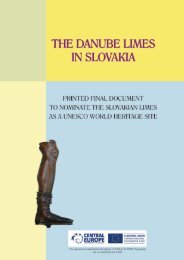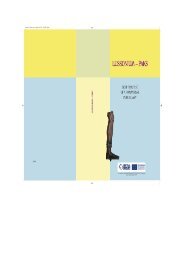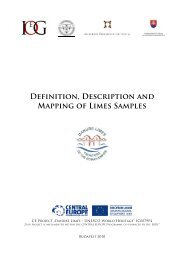the PDF version! - Danube Limes
the PDF version! - Danube Limes
the PDF version! - Danube Limes
Create successful ePaper yourself
Turn your PDF publications into a flip-book with our unique Google optimized e-Paper software.
Frontiers of <strong>the</strong> Roman Empire – Ripa Pannonica in Hungary (RPH) Nomination statement<br />
ruins have been exposed particular care must be taken, and until a permanent solution is found seasonal<br />
protection from frost must be provided. In <strong>the</strong> case of final rehabilitation, conservation or exhibition,<br />
solutions to <strong>the</strong> problems of water infiltration and frost for <strong>the</strong> remains must be found through water<br />
management, insulation/damp-proofing and <strong>the</strong> employment of proper techniques for interventions. The<br />
regulations for interventions are controlled by strict official supervision, and special post-graduate training<br />
exists for <strong>the</strong> acquisition of <strong>the</strong>se design techniques.<br />
Air pollution that damages construction materials characteristically exerts its impact through moisture.<br />
Protection of <strong>the</strong> elements of <strong>the</strong> ruins against moisture also neutralizes most airborne threats.<br />
The aforementioned, legally binding National Regional Development Plan includes prohibitive provisions:<br />
Chapter VI, section 22/A (2) New surface mining sites cannot be established within <strong>the</strong> zone, and <strong>the</strong> area<br />
of existing surface mining sites cannot be expanded.<br />
(iii) Natural Disasters (earthquakes, floods, fires)<br />
Hungary is not a seismically threatened area. A yearly average of 100-150 minor quakes occur, which do<br />
not exceed a strength of 3.5 measured on <strong>the</strong> Richter scale. Quakes that cause damage occur approximately<br />
every forty years, and serious earthquakes every 400 years.<br />
The <strong>Danube</strong> River has threatened <strong>the</strong> structures of <strong>the</strong> Ripa Pannonica since <strong>the</strong>ir construction, or<br />
for nearly two thousand years. The section of <strong>the</strong> <strong>Danube</strong> that runs north-south has been gradually<br />
shifting to <strong>the</strong> west, away from <strong>the</strong> direction of <strong>the</strong> Earth’s rotation. This process is slow, but water has<br />
washed <strong>the</strong> eastern side of many forts and watch towers into <strong>the</strong> <strong>Danube</strong>. There are also spectacular<br />
periods for slow processes. The <strong>Danube</strong> has a high right bank after it flows through Budapest. This<br />
riverbank is made of loess, and according to evidence from old maps and records from time to time<br />
significant pieces break off into <strong>the</strong> <strong>Danube</strong>. In 1860 one million cubic meters slid off at Dunaszekcső,<br />
two million cubic meters came off at Dunaújváros in 1965 and ano<strong>the</strong>r one million cubic meters at<br />
Dunaföldvár in 1970. The latest was a spectacular landslide that occurred on <strong>the</strong> 12 th of February 2008<br />
and unfortunately affected <strong>the</strong> already damaged Dunaszekcső fort. The river bank broke off on a 300<br />
meter long and 30-35 meter wide section, and subsided about 10 meters, taking along with it <strong>the</strong> most<br />
recent portion of <strong>the</strong> Lugio fort as well as significant archaeological evidence from <strong>the</strong> ground’s cultural<br />
layers. The continuing danger of landslides rules out any opportunity for excavation. The government<br />
is planning measures to stabilize <strong>the</strong> riverbank, but no interventions have occurred yet.<br />
The o<strong>the</strong>r characteristic of <strong>the</strong> <strong>Danube</strong> that causes problems is <strong>the</strong> danger of floods. The flood prevention<br />
measures developed since <strong>the</strong> second half of <strong>the</strong> 19 th century safeguard <strong>the</strong> individual structures of <strong>the</strong><br />
Ripa on <strong>the</strong> protected side. The flooding of <strong>the</strong>se can occur in extraordinary cases, approximately every<br />
fifty years if <strong>the</strong> water overflows <strong>the</strong> levees despite <strong>the</strong>ir reinforced protection. This would be an act of God<br />
that cannot be avoided. The remains that are still within <strong>the</strong> flood plains, primarily fortified river ports,<br />
crossings and signal towers are exposed to flood waters once or twice a year. The rehabilitation of <strong>the</strong>se<br />
must be resolved in a stable manner through hydraulic construction means, but even <strong>the</strong>n <strong>the</strong>y cannot be<br />
protected from floods caused by ice dams. It is only possible to think about rehabilitation in <strong>the</strong> case of<br />
outstandingly significant remains, in o<strong>the</strong>r cases only <strong>the</strong> condition that has evolved through <strong>the</strong> action<br />
of <strong>the</strong> water can be maintained.<br />
Wildfires and forest fires do not represent a significant danger in Hungary.<br />
63











